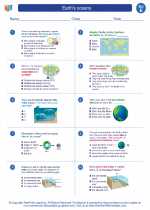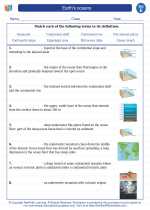Earth's oceans -> circulatory system
Circulatory System
Definition:
The circulatory system, also known as the cardiovascular system, is a network of organs and vessels that is responsible for the transport of blood, nutrients, oxygen, and waste products throughout the body.
Key Components:
- Heart: The muscular organ that pumps blood throughout the body.
- Blood Vessels: Tubes that carry blood to and from the heart, including arteries, veins, and capillaries.
- Blood: Fluid that carries oxygen, nutrients, and waste products throughout the body.
Functions:
The circulatory system has several important functions:
- Transport: It transports oxygen, nutrients, and hormones to cells, and removes waste products such as carbon dioxide and metabolic waste.
- Regulation: It helps regulate body temperature, pH levels, and fluid balance.
- Protection: It plays a role in the immune response and clotting to prevent excessive bleeding.
Key Concepts:
Understanding the following concepts is important for learning about the circulatory system:
- Double Circulation: The circulatory system has two circuits - the pulmonary circuit, which carries blood to the lungs for oxygenation, and the systemic circuit, which carries oxygenated blood to the rest of the body.
- Heart Chambers: The heart has four chambers - the left and right atria (upper chambers) and the left and right ventricles (lower chambers).
- Blood Types: There are four main blood types - A, B, AB, and O - and blood is also classified by the presence of antigens and antibodies.
Study Tips:
Here are some tips for studying the circulatory system:
- Visual Aids: Use diagrams and models to understand the structure and function of the heart, blood vessels, and blood flow.
- Practice Quizzes: Test your knowledge with practice quizzes on the components and functions of the circulatory system.
- Real-life Examples: Relate the concepts to real-life examples, such as exercise and the effects on heart rate and blood flow.
◂Science Worksheets and Study Guides Fifth Grade. Earth's oceans
Study Guide Earth's oceans
Earth's oceans  Worksheet/Answer key
Worksheet/Answer key Earth's oceans
Earth's oceans  Worksheet/Answer key
Worksheet/Answer key Earth's oceans
Earth's oceans  Worksheet/Answer key
Worksheet/Answer key Earth's oceans
Earth's oceans  Vocabulary/Answer key
Vocabulary/Answer key Earth's oceans
Earth's oceans  Vocabulary/Answer key
Vocabulary/Answer key Earth's oceans
Earth's oceans 

 Worksheet/Answer key
Worksheet/Answer key
 Worksheet/Answer key
Worksheet/Answer key
 Worksheet/Answer key
Worksheet/Answer key
 Vocabulary/Answer key
Vocabulary/Answer key
 Vocabulary/Answer key
Vocabulary/Answer key

The resources above cover the following skills:
EARTH AND SPACE SCIENCE
Earth’s Systems
Identify the distribution of freshwater and salt water on Earth (e.g., oceans, lakes, rivers, glaciers, ground water, polar ice caps) and construct a graphical representation depicting the amounts and percentages found in different reservoirs.